The U.S. Army has developed a standard set of hardware and software that, once installed in a human-vehicle, allows the vehicle to be operated remotely or even in a semi-autonomous fashion. The Army’s goal is unmanned fighting vehicles that can operate along manned fighting vehicles, and convoys of unmanned vehicles that can travel routes autonomously or following the lead of a human driver. The service faces significant challenges, however, as the two-dimensional aspect of unmanned ground is more difficult than unmanned air.
In an exclusive to Breaking Defense, the U.S. Army’s Ground Vehicles Systems Center revealed it has a suite of hardware and software capable of transforming manned vehicles to unmanned ones. The Army has tested it on more than 20 different vehicles, from Humvees to aging M113 armored personnel carriers. It has even installed the kit on German trucks used by the British Army that had the steering wheel, brakes, and other controls on the left hand side.
The U.S. Army wants several things out of this concept. One of the most important is the Optionally Manned Fighting Vehicle (OMFV), the anticipated replacement for the M2 Bradley infantry fighting vehicle. OMFV will, as it name implies, occasionally operate without a human crew. The Army also wants unmanned trucks and cargo vehicles, saving humans from drudgery—and danger—of driving trucks near battlefields.
Unmanned ground vehicle (UGV) development is uniquely different and, perhaps counterintuitively, more difficult than unmanned air. There are no obstacles in the air, nor are there any roads to follow. Aircraft can move in three dimensions, allowing greater flexibility in dealing with problems.
Meanwhile, UGVs are stuck with a two dimensional landscape littered with obstacles. An obstacle like a boulder or tank trap must be detected, assessed, and then overcome. UGVs must generally follow roads for the smoothest, most direct ride. The devastation of war also means that a road or bridge that is there one day might not be there the next. All of this is an order of magnitude harder than your typical self-driving car road conditions.
All of that being said, the Army’s vehicles are not being taught to fight on their own. That’s a whole different matter altogether, and for now the service is committed to keeping a man in the loop who will approve each potential target, making sure unmanned systems don’t engage noncombatants.

No comments:
Post a Comment